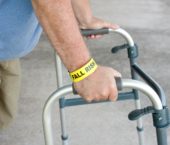Our goal is to prevent all falls. Although they are not always preventable, with the assistance of your health care professional they can be fewer in number an less in severity.
There are many factors that put you at risk for injury due to falls in your home. This information is meant to increase your understanding of safe movement and transfer techniques. Our professional team will monitor our risk for falls on an ongoing basis and work with your on continued preventions of injury.
Remember
- Our goal is to keep your comfortable, keep you safe, to keep you free from pain
- Your safety and well being is our concern
- Your nurse is available to answer any questions you might have
- There are many different types of equipment available that can assist you so that you can be safe and injury free.
Canes
There are various canes that can be used, but, remember:
- The cane should be used on the stronger (unaffected) side of your body: If your right side is weaker, hold the cane in your left hand. Move the cane as you move your right leg. Then move your left leg.
- Always practice first with someone standing beside you before you do it on your own.
Walkers
Walkers are used when you have generalized weakness and instability. Remember:
- Place your hands on the handle grips on both sides of the walker with slight flex at the elbows. When you walk mover the walker first then step into it. Only move the walker on step.
- To rise from a sitting position, use the arms of the chair to push your body to a standing position. Do not pull your body into an upright position using the walker.
Sitting
Proper posture encourages good circulation, comfort, optimal respiratory function, prevents falls and prevents complications related to skin integrity. Remember:
- Align your head and spine and keep your back straight
- Support both arms with armrests
- Keep your legs uncrossed
- Keep both feet flat on the floor
Wheel chairs
Wheel chairs are often used when poor endurance leads to immobility as well as when you find it difficult to bear weight. Remember:
- Always make sure the wheels are locked when transferring in or out of the wheel chair.
- Maintain proper sitting alignment.
- Have wheel chair maintained in good mechanical condition.
- Servicing is available through your medical equipment supplier.
Transfers
Transferring from bed to chair and from chair to bed properly is an important part of maintaining your mobility. Remember:
- Plan your move before taking action and make sure the area is clear of clutter.
- Always know your limits and call for help if needed.
- Ask questions, demonstrate what your know to your nurse and follow all instructions.
In the event of a fall
If you should find yourself falling, the following will help to minimize injury, Remember:
- Protect your head and face and do not try to break the fall.
- If possible, don’t move until you are checked by another person.
- If there is no one available, attempt to move very slowly until the extent of injury is know. Notify your nurse or family as soon as possible after the fall (even if you do not think your have any injury).

